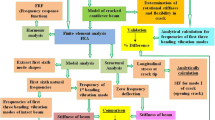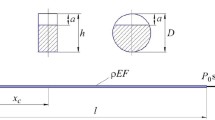The results of computational experiments for determining the effect of a mode I surface fatigue crack cross-sectional shape in a rectangular cantilever beam on the characteristics of its free and forced bending vibrations with varying cross-sectional dimensions of the crack and its longitudinal position are presented. Finite-element models of beams with 8-node 3D finite elements were developed for carrying out investigations. Three types of a breathing crack cross-section were considered: rectangular, triangular, and trapezoidal one, with the solution of a contact problem to ensure the non-penetration of crack edges. Plots of relative change in the natural frequency of vibration, the amplitudes of the first and second harmonics and their ratios at the main, super- and subharmonic resonances versus the shape, relative area and location of the crack were obtained. It is shown that when bending vibrations of the beam with a rectangular crack, are excited along the axis Oy, there arise displacements only in the direction of driving force, while in the case of triangular and trapezoidal cracks, there arise additional displacements along the axis of minimum stiffness, Oz. It was found that the change in the natural frequency of the beam, as well as the ratio of the amplitudes of dominant harmonics during the recording of vibrations along the excitation axis at the main, super- and subharmonic resonances increase with increasing relative area of the crack cross-section. Under this condition, their largest value was characteristic of a rectangular crack, and the smallest of a triangular one. It was noted that a characteristic indicator of the asymmetric shape of the crack was the appearance of vibrations in the plane perpendicular to the excitation plane.









Similar content being viewed by others
References
B. Panigrahi and G. Pohit, “Nonlinear modelling and dynamic analysis of cracked Timoshenko functionally graded beams based on neutral surface approach,” P. I. Mech. Eng. C-J. Mec., 230, No. 9, 1486–1497 (2016).
A. C. Neves, F. M. F. Simoes, and A. Pinto da Costa, “Vibrations of cracked beams: Discrete mass and stiffness models,” Comput. Struct., 168, 68–77 (2016).
H. Long, Y. Liu, C. Huang, et al., “Modelling a cracked beam structure using the finite element displacement method,” Shock Vib., 2019, Article ID 7302057 (2019), https://doi.org/https://doi.org/10.1155/2019/7302057.
R. O. Curadelli, J. D. Riera, D. Ambrosini, and M. G. Amania, “Damage detection by means of structural damping identification,” Eng. Struct., 30, 3497–3504 (2008).
E. Asnaashari and J. K. Sinha, “Development of residual operational deflection shape for crack detection in structures,” Mech. Syst. Signal Pr., 43, 113–123 (2014).
P. E. Cooley, J. C. Slater, and O. V. Shiryayev, “Investigation of a vibration-based damage identification technique for breathing fatigue cracks,” in: Proc. of the 56th AIAA/ASME/ASCE/AHS/ASC Structures, Structural Dynamics, and Materials Conf. (Kissimmee, Florida, USA) (2015), https://doi.org/https://doi.org/10.2514/6.2015-0693.
W. Zhang, H. Ma, J. Zeng, et al., “Vibration responses analysis of an elastic-support cantilever beam with crack and offset boundary,” Mech. Syst. Signal Pr., 95, 205–218 (2017).
E. A. Sinenko and A. P. Zinkovskii, “Influence of the exciting force application point on the amplitude spectrum of flexural vibrations in a beam with a “breathing” crack,” Strength Mater., 47, No. 4, 553–560 (2015), https://doi.org/https://doi.org/10.1007/s11223-015-9689-0.
V. V. Matveev, A. P. Yakovlev, O. E. Boginich, and E. A. Sinenko, “Approximate analytical determination parameters of vibrodiagnostic parameters of the presence of a closing crack in bar elements under subharmonic resonance,” Strength Mater., 46, No. 3, 315–237 (2014), https://doi.org/https://doi.org/10.1007/s11223-014-9553-7.
V. V. Matveev, O. E. Boginich, E. A. Sinenko, and A. P. Yakovlev, “On vibrodiagnostics of the presence of a closing edge crack in a beam with amplitude-dependent damping capacity under superharmonic resonance,” Strength Mater., 47, No. 5, 653–661 (2015), https://doi.org/https://doi.org/10.1007/s11223-015-9701-8.
J. Zeng, H. Ma, W. Zhang, and B. Wen, “Dynamic characteristic analysis of cracked cantilever beams under different crack types,” Eng. Fail. Anal., 74, 80–94 (2017).
A. Bouboulas and N. Anifantis, “Three-dimensional finite element modeling for post-buckling analysis of cracked columns,” Int. J. Struct. Integr., 7, No. 3, 397–411 (2016).
T. Y. Kam and T. Y. Lee, “Detection of cracks in structures using modal test data,” Eng. Fract. Mech., 42, No. 2, 381–387 (1997).
Y. S. Lee and M. J. Chung, “A study on crack detection using eigenfrequency test data,” Comput. Struct., 77, 327–342 (2000).
H. Long, Y. L. Liu, and K. F. Liu, “Nonlinear vibration analysis of a beam with a breathing crack,” Appl. Sci., 9, 1–17 (2019).
J. Liu, Y. Shao, and W. Zhu, “Free vibration analysis of a cantilever boam with a slant edge crack,” P. I. Mech. Eng. C-J. Mec., 231, No. 5, 823–843 (2017).
A. P. Zinkovskii and I. G. Tokar’, “Influence of local surface damage on the natural frequencies of the higher modes of flexural vibration of cantilever rods,” Strength Mater., 50, No. 4, 557–564 (2018), https://doi.org/https://doi.org/10.1007/s11223-018-0001-y.
U. Andreaus, P. Casini, and F. Vestroni, “Nonlinear features in the dynamic response of a cracked beam under harmonic forcing,” in: Proc. of the 2005 ASME International Design Engineering Technical Conferences and Computers and Information in Engineering Conference (Sept. 24–28, 2005, Long Beach, CA, USA), Vol. 6C, DETC2005-85672, ASME (2005), pp. 2083–2089.
U. Andreaus, P. Casini, and F. Vestroni, “Non-linear dynamics of a cracked cantilever beam under harmonic excitation,” Int. J. Nonlin. Mech., 42, 566–575 (2007).
N. M. Newmark, “A method of computation for structural dynamics,” J. Eng. Mech. Div.-ASCE, 85, 67–94 (1959).
O. Giannini, P. Casini, and F. Vestroni, “Nonlinear harmonic identification of breathing cracks in beams,” Comput. Struct., 129, 166–177 (2013).
Author information
Authors and Affiliations
Corresponding author
Additional information
Translated from Problemy Mitsnosti, No. 2, pp. 17 – 27, March – April, 2022.
Rights and permissions
About this article
Cite this article
Onyshchenko, E.O., Zinkovskii, A.P. & Matveev, V.V. Determination of the Effect of a Mode I Surface Crack Cross-Sectional Shape on the Characteristics of the Forced Bending Vibrations of a Cantilever Beam. Strength Mater 54, 178–187 (2022). https://doi.org/10.1007/s11223-022-00393-4
Received:
Published:
Issue Date:
DOI: https://doi.org/10.1007/s11223-022-00393-4




